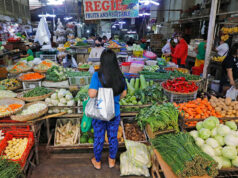Inflation for low-income households eases further in January
INFLATION, as experienced by low-income households, was lower in January as prices of food and utilities eased further, the Philippine Statistics Authority (PSA) reported on Friday.
The January inflation turnout for goods and services used by households at the bottom 30% income segment stood at 5.9%, slower than the year-on-year price increase of 7.2% in December 2018.
The consumer price index (CPI) for the bottom 30% income segment has a heavier weighting for the food, beverages and tobacco subindex, seen to more accurately represent the spending patterns of the poor.
The food, beverages and tobacco subindex rose 6.7% year on year from 8.1% in December 2018. Food alone logged a 5.8% growth versus the previous month’s 7.1%.
Slower upticks were noted in the following food groups in January: rice at 6.8% in January from 7.8% the previous month; fish (8.7% from 10.5%); fruits and vegetables (5.7% from 8.7%); miscellaneous foods (5.5% from 5.9%); meat (4.8% from 5.6%), eggs (2.6% from 3%), cereal preparations (4% from 4.1%), and dairy products (3.7% from 3.8%). Meanwhile, the price of corn went down 0.7% from last year’s 1.2% growth.
The cost of utilities, consisting of fuel, light and water, decelerated to 3.4% from December’s 5.3%. Lower increases were also recorded in housing and repairs (4.6% from 5.5%), and services (3.5% from 3.6%).
Meanwhile, the clothing and “miscellaneous” subindices were steady at 3.1% and 2.4%, respectively.
Inflation experienced by poor households in the National Capital Region (NCR) was recorded at 4%, slower than the 4.8% posted in December. A similar case was observed for those living outside of Metro Manila, which recorded slower inflation at 5.9% from 7.3%.
“The downtrend in inflation bodes well for economic growth and the lives of Filipinos as this will restore lost purchasing power in 2019, aiding overall household consumption,” Nicholas Antonio T. Mapa, senior economist at ING N.V.-Manila branch, said in an email.
“The deceleration in the print moves in line with the current path of inflation now that supply conditions have eased. This can be expected from inflation that had been primarily driven by cost-push pressures: inflation comes down very quickly once supply bottlenecks have been addressed,” he said.
“Lastly, we note the 4.6% inflation in housing repairs in areas outside NCR, in particular the north, reflecting possible ongoing repairs after severe storm damage seen in these areas towards the end of 2018.” — Marissa Mae M. Ramos



